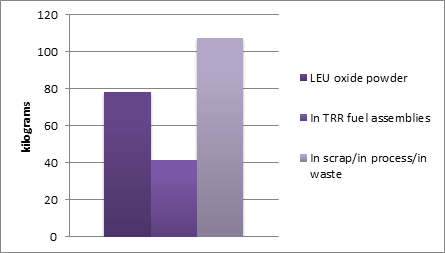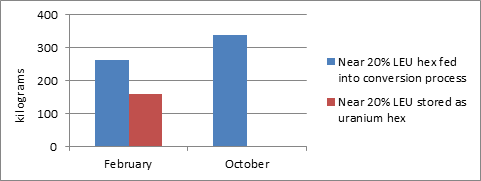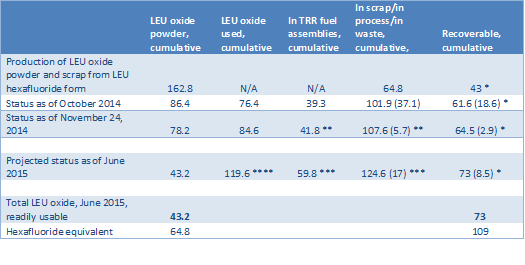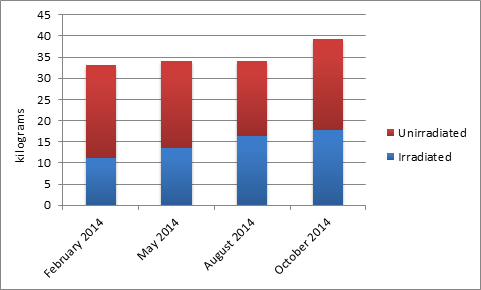Reports
Iran’s Stock of near 20 Percent LEU under the Extension of the Joint Plan of Action
by David Albright, Paulina Izewicz, and Andrea Stricker
December 8, 2014
Summary
Despite the fact that Iran no longer has a stock of near 20 percent low enriched uranium (LEU) in hexafluoride form, it retains a significant portion of this material in the form of oxide. Under the July 2014 extension of the interim deal of the Joint Plan of Action, Iran pledged to convert 25 kilograms of LEU oxide into fuel assemblies for the Tehran Research Reactor. The goal of this step was to reduce the ease of reconverting this uranium oxide and using it in a breakout to nuclear weapons. However, only about 5-10 kilograms of this near 20 percent LEU actually ended up in the fuel. In the most recent extension, Iran committed to use another 35 kilograms for that purpose. Although the efficiency rates are expected to be higher this time, Iran will still retain large amounts of near 20 percent LEU in both oxide powder and in scrap, in-process material and in waste. The figure below shows that far more LEU, almost triple the amount, is ending up in scrap and waste than in fuel assemblies. The bulk of this LEU is recoverable and usable in fuel or in a breakout to nuclear weapons.
Figure i. Near 20 percent LEU oxide as of November 24, 2014 (in kilograms, uranium mass).

Source: Implementation of the NPT Safeguards Agreement and relevant provisions of Security Council resolutions in the Islamic Republic of Iran, November 7, 2014; Status of Iran’s Nuclear Programme in relation to the Joint Plan of Action, November 24, 2014.
According to our understanding, in the recent extension deal, Iran has committed not to work on the near 20 percent LEU scrap. In the long term agreement, one solution for the material outside of fuel assemblies is to send it out of Iran for further processing and storage or disposal. Any LEU abroad could be fabricated into fuel assemblies at a later date in Iran or at a foreign fuel fabricator. In either case, the LEU would be returned to Iran when a need for such fuel was verifiably demonstrated.
There appears to be a significant misunderstanding with respect to this issue, as evidenced by recent reporting and analysis. While it is true that Iran has committed to use an additional 35 kilograms of its LEU oxide powder stockpile to manufacture fuel assemblies, this does not, in fact, mean that those 35 kilograms will actually end up in the fuel – as discussed in detail in this report. Such misunderstandings are only natural given the highly technical nature of the matter at hand. Nevertheless, it is very important to be circumspect in approaching this issue, as a lot is at stake.
Several media outlets and groups, including Al Monitor, Arms Control Association (ACA), and the National Iranian American Council (NIAC) have omitted this aspect of the story in their reporting on the extension agreement. For example, ACA and Al Monitor both stated, “Iran will convert 35 additional kg of its [ACA stated Iran’s] remaining 75 kg of 20% oxide into reactor fuel,” without discussing the large fraction of near 20 percent LEU that has not ended up in fuel assemblies. NIAC did the same in a policy memo with a few more words added for clarity’s sake and made more mistakes in its reporting on the extension. These groups have little in-house technical expertise and thus should avoid making snap judgments without the added background of technical analysis. However, this explanation does not completely explain the errors and omissions. The information about the TRR fuel is readily available in International Atomic Energy Agency reports and each of these groups analyzes to some extent these reports. In addition, although perhaps not intentionally due to the confusion over the provisions, these groups also mistakenly reported on the limitations in the November extension agreement, incorrectly describing additional monitoring as “snap” inspections and misunderstanding limitations on the IR-6 centrifuge.
But as an another problem, there appears to be groupthink going on among some of these and other groups leading to a willingness to uncritically and unwaveringly support the interim deal and defensively react to any compliance questions. In the past, at least, individuals from these three groups in particular participated in a Ploughshares Fund sponsored Iran listserv that shared and shaped positions on addressing the Iranian nuclear issue in the media and in analysis. Based on ISIS staff’s experience as participants on this listserv a few years ago, this shaping too often devolved into poor analysis. ISIS first attempted to improve and correct analysis, and then ISIS staff decided to remove themselves from the listserv. It is unclear if the groupthink element and one-sided shaping are happening here, or if the listserv still exists, but it is worth asking.
Introduction
As confirmed by the International Atomic Energy Agency (IAEA), Iran no longer has a stock of near 20 percent low enriched uranium (LEU) in hexafluoride form (see table 1). However, it should be noted that it retains a significant portion of this material in a different chemical form, oxide (see figure 1). Under the first extension of the Joint Plan of Action (JPA), Iran committed to manufacturing 25 kilograms of LEU oxide into fuel assemblies for the Tehran Research Reactor (TRR). Although a straightforward reading of this pledge might have suggested that those 25 kilograms would actually end up in the fuel assemblies, they did not. Only about 5.2 kilograms did so as of October 2014 out of the 17 kilograms used to make the fuel assemblies. Under the latest extension, Iran has committed to use another 35 kilograms of LEU oxide to make TRR fuel assemblies by June 2015. Based on the previous developments, this suggests that the amount contained in fuel will not be, in fact, 35 kilograms, but a significantly smaller amount.
Production of near 20 Percent LEU Oxide Powder and Scrap
Overall, Iran has fed 337.2 kilograms of near 20 percent LEU hexafluoride into the conversion process at Esfahan. It is convenient to consider only the mass of the uranium contained in this material, which is 227.6 kilograms. In the remainder of this report, all values given – unless otherwise stated – represent the uranium mass.
The conversion process resulted in the production of 162.3 kilograms in oxide powder form. In its November 2014 report, the IAEA informed that an additional 0.5 kilograms were produced from the material which had previously been in the conversion process. This brings the total to 162.8 kilograms. A total of 54.4 kilograms were contained in scrap, and about 10.4 kilograms remained in the process and in waste, for a total of 64.8 kilograms.
Table 1. October 17, 2014 inventory and fate of UF6 enriched up to 20 percent LEU (hexafluoride mass)

Source: Implementation of the NPT Safeguards Agreement and relevant provisions of Security Council resolutions in the Islamic Republic of Iran, November 7, 2014; Status of Iran’s Nuclear Programme in relation to the Joint Plan of Action, July 20, 2014.
Figure 1. Feeding of near 20 Percent LEU hexafluoride into the Conversion Process, at beginning of the Interim Period, namely February 2014, and in October 2014 (kilograms LEU hexafluoride).

Note: This figure demonstrates that while one chemical form of the near 20 percent enriched uranium (uranium hexafluoride) was eliminated, the other (uranium oxide) increased. Source: Implementation of the NPT Safeguards Agreement and relevant provisions of Security Council resolutions in the Islamic Republic of Iran, November 7, 2014.
LEU contained in scrap and in-process material can be reused after recovery. Scrap material has significant value and Iran would be expected to recover much of it for conversion into usable uranium oxide. Overall, it is estimated that Iran would be able to recover up to 43 kilograms of this 64.8 kilograms in scrap and waste.1
Production of Fuel Assemblies for the Tehran Research Reactor
As of October 2014, Iran had used 76.4 kilograms of LEU oxide to manufacture fuel assemblies for TRR, bringing its near 20 percent LEU oxide powder stock down to 86.4 kilograms. This transformation offers advantages to slow potential breakout times. When in fuel assemblies, the LEU is in a less reconvertable form.
Using the 76.4 kilograms, Iran manufactured five TRR test plates (75 grams each), nine control fuel rods (1,000 grams each), 21 standard fuel assemblies (1,400 grams each), and one test assembly (550 grams), for a total of 39.3 kilograms. The fate of the 37.7 kilograms not in the fuel is not discussed in the IAEA report. It could be in process lines, scrap, waste, or in storage tanks linked to the manufacturing process. About 18.6 kilograms of this material are estimated as potentially recoverable.2
Table 2 tabulates these values historically and projects the situation in June 2015. Figure 2 shows graphically the results as of November 24, 2014.
The efficiency rate was very low for the approximately 17 kilograms of LEU oxide powder fed into the TRR fuel manufacturing line from late July (when the deal was extended) to October, resulting in only about 5.2 kilograms ending up in the fuel assemblies. About 70 percent of the LEU oxide powder used ended up in scrap, process lines, or waste.3
As of November 24, 2014, when the first extension of the JPA came to an end, Iran had used a total of 84.6 kilograms to manufacture fuel assemblies, compared to 76.4 kg as of October. It is unknown how much of this additional LEU, which amounts to about 8 kilograms, ended up in fuel assemblies, but it is a small quantity. Based on the July – October efficiency rates, this amount is estimated at about 2.5 kilograms, bringing the total amount in the fuel assemblies to about 42 kilograms as of November 24.
In total, as of November 24, 84.6 kilograms of LEU oxide powder had yielded about 42 kilograms in TRR fuel assemblies and left about 43 kilograms in scrap, in process lines, and in waste. Adding the 65 kilograms of scrap and waste generated during the conversion of near 20 percent LEU hexafluoride into oxide powder, the total amount in scrap, process lines, and waste was about 108 kilograms (see table 2 and figure 2). About 64 kilograms of this material are estimated as potentially recoverable. Thus, a relatively large fraction remains in scrap and waste and potentially readily available in a breakout.
Figure 2. Near 20 percent LEU oxide as of November 24, 2014 (in kilograms, uranium mass).

Source: Implementation of the NPT Safeguards Agreement and relevant provisions of Security Council resolutions in the Islamic Republic of Iran, November 7, 2014; Status of Iran’s Nuclear Programme in relation to the Joint Plan of Action, November 24, 2014.
The resumption in the production of fuel assemblies did not actually start until at least August instead of July. Figure 3 shows that between May 2014 and August 2014, the amount of near 20 percent LEU in fuel assemblies remained unchanged. Thus, Iran appears to have tried to process a relatively large amount of LEU oxide in two to three months, or about 8-12 kg per month, possibly helping explain the inefficient use of the LEU. Because of this very low efficiency rate, under the latest JPA extension, Iran has committed to use a total of 35 kilograms of LEU oxide to manufacture TRR fuel assemblies during the next seven months, at an average rate of approximately 5 kilograms per month. In essence, Iran is slowing down its fuel fabrication rate with the intention to place more of the LEU into fuel assemblies.
Table 2. Production and fate of near 20 percent LEU oxide in Iran (in kilograms, rounded to one decimal place)

Comments Note: Numbers in parentheses in columns 5 and 6 denote an increase since the last indicated period. Between July and October 2014, 25.3 kg were used to produce 5.2 kg in fuel assemblies; an estimated 20.1 were in scrap, in process, or in waste. * Estimate, assuming 70 percent recoverable from scrap and 50 percent from waste and in-process material for oxide manufacturing and 50 percent for all such material generated in the production of fuel assemblies ** Estimate, based on the July - November efficiency rate, which was very low. *** Estimate, based on the higher, overall, efficiency rates, up to October 2104, or 39.3 divided by 76.4 which equals 51.4 percent **** Amount used as of November 24, 2014, plus the 35 kg stipulated for fuel manufacturing under the November 2014 extension of the JPA. Source: Implementation of the NPT Safeguards Agreement and relevant provisions of Security Council resolutions in the Islamic Republic of Iran, November 7, 2014; Status of Iran’s Nuclear Programme in relation to the Joint Plan of Action, November 24, 2014.
Consequently, by the end of this most recent extension, or in June 2015, Iran is expected to have used approximately 119.6 kilograms of LEU oxide powder to make TRR fuel assemblies, leaving about 43.2 kg as oxide powder. Applying the higher efficiency rates typical of the overall process thus far, from November 2014 to June 2015, an additional 18 kilograms would end up in fuel assemblies, bringing the cumulative amount to about 60 kilograms. The cumulative fuel manufacturing process is expected to yield a total of about 60 kilograms of material in scrap, in process and in waste. Adding the 65 kilograms of scrap and waste generated during the conversion of near 20 percent LEU hexafluoride into oxide powder, the total amount in scrap, process lines, and waste would be about 125 kilograms. About 73 kilograms of this material are estimated as potentially recoverable.
Reducing the Risk Posed by LEU Stockpile in a Long Term Deal
One way to significantly reduce the breakout risk posed by the near 20 percent LEU stock is to irradiate the LEU in the TRR. Once irradiated, the LEU fuel poses a radiation risk and would need to be separated in heavily-shielded facilities, a difficult and time consuming process. As Iran continues to fuel the TRR, more material will be irradiated. Thus, Iran would be unlikely to be able to draw upon its entire estimated stock of converted LEU oxide. As of October 2014, Iran had irradiated two test plates (75 grams each), five control fuel assemblies (1,000 grams each) and nine (up from eight in the previous reporting period) standard fuel assemblies (1,400 grams each) – 17.75 kilograms in total (see figure 3).
Figure 3. Amounts of near 20 percent LEU (uranium mass) in kilograms contained in fuel assemblies for the Tehran Research Reactor

Source: Implementation of the NPT Safeguards Agreement and relevant provisions of Security Council resolutions in the Islamic Republic of Iran, February – November 2014.
Over the next several years, the TRR, which is a small reactor, is expected to irradiate less than the equivalent of tens of kilograms of near 20 percent LEU hexafluoride. Thus, irradiation is not expected to be a viable option, by itself, to reduce the risk posed by the near 20 percent LEU.
One possible compromise in a comprehensive solution would be for Iran to manufacture its entire stock of near 20 percent LEU oxide powder – by June 2015 expected to be about 43 kilograms - into fuel assemblies. Although it should be noted that LEU contained in fuel assemblies is recoverable, the process would take longer than if the material was in uranium oxide powder form and thus it is preferable to put it into fuel than leave it as an oxide powder. Nevertheless, as shown above, this method is not entirely satisfactory either. Iran will retain a large stock of LEU in scrap and waste, about 125 kilograms by June 2015, about double the amount in TRR fuel assemblies. One solution for the material outside of fuel assemblies, consistent with the goal of lengthening breakout times, is to send it out of Iran for further processing and storage or disposal. Any recovered LEU could be fabricated into fuel assemblies at a later date in Iran or abroad. In any case, this material would be returned to Iran when a need for it was verifiably demonstrated.
1 This calculation is based on the assumption that about 70 percent of LEU in scrap, and about 50 percent of the in-process inventory, could be recovered. For a more detailed discussion of the reconvertability of different chemical forms of uranium, see: David Albright, Patrick Migliorini, Christina Walrond, and Houston Wood, “Update on Iran’s Total Near 20 Percent Enriched Uranium Stock: Nearly Enough for a Bomb, if Further Enriched,” ISIS Report, March 11, 2014, http://isis-online.org/uploads/isis-reports/documents/twenty_percent_stock_march_11_2014-final.pdf 2 Material in scrap, in process and in waste has different recoverability rates. A rate of 70 percent for material in scrap, and 50 percent for material in process and in waste is assumed for the manufacturing of hexafluoride into oxide. Here, the precise composition of the material “leftover” from the production of TRR fuel assemblies is unknown; a lower recoverability rate of 50 percent is assumed. 3 The fraction in fuel assemblies is 5.2 divided by 17.1, or 30 percent.

 twitter
twitter